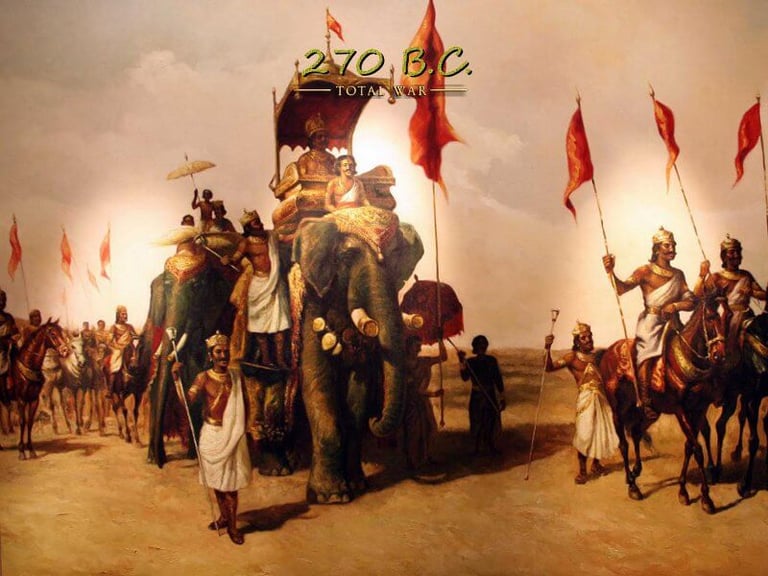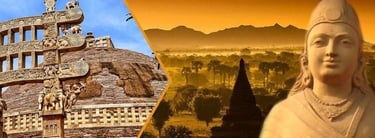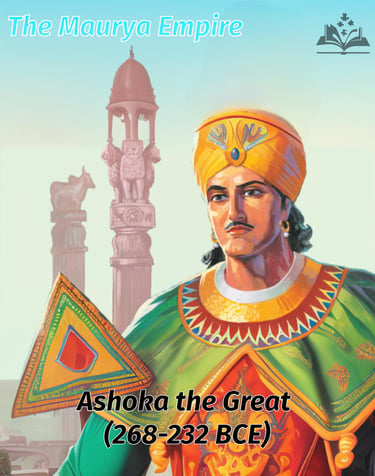
The Maurya Empire: A Pioneering Force in Ancient Indian History!
Discover the rich history of the Maurya Empire, one of the greatest empires of ancient India. Learn about its rise under Chandragupta, Ashoka's transformation through Buddhism, and the empire's lasting contributions to governance, culture, and religion.
INDIAN HISTORYTHE GREAT LEADEREMPIRES/HISTORYHISTORY
Sachic K Chaurasiya
9/8/20246 min read


One of the largest and most influential empires in Indian history, the Maurya Empire (मौर्य साम्राज्य) played a vital role in shaping the political, cultural, and economic fabric of the Indian subcontinent (भारतीय उपमहाद्वीप). Founded by Chandragupta Maurya (चन्द्रगुप्त मौर्य) in 322 BCE, the Maurya dynasty was known for its centralized rule, military prowess, and the spread of Buddhism. At its peak under Emperor Ashoka (सम्राट अशोक), the empire stretched from modern-day Afghanistan to Bangladesh, encompassing almost the entire Indian subcontinent. This article explores an in-depth history of the Maurya Empire, highlighting its origins, major rulers, contributions to governance, and lasting legacy.
The Origins of the Maurya Empire
The Maurya Empire (मौर्य साम्राज्य) arose during a period of political instability in northern India. The fall of the Nanda dynasty (नंदा राजवंश), which had ruled much of the Gangetic plain (गंगा का मैदान), left a power vacuum. Amid this uncertainty, a young and ambitious warrior named Chandragupta Maurya founded a new empire that transformed the Indian landscape.
1.1 Chandragupta Maurya: The Founder
Chandragupta Maurya (चन्द्रगुप्त मौर्य) (322–297 BCE) was the first ruler of the Maurya Empire and is widely regarded as the architect of ancient India's first major centralized state. According to historical accounts, Chandragupta, under the guidance of the brilliant strategist Chanakya (चाणक्य) (also known as Kautilya/कौटिल्य), overthrew the Nanda dynasty and annexed the Magadha region, whose capital was Pataliputra (modern Patna).
Chandragupta's rise to power was not just about military conquests but also about forging strategic alliances. He formed an alliance with the Greek general Seleucus I, one of Alexander the Great's successors, gaining valuable territory in exchange for diplomatic ties, including a marriage alliance. Chandragupta's empire soon expanded into the northern plains of India, laying the foundation for future expansion.
1.2 Chanakya’s Role and the Arthashastra
Chanakya (चाणक्य), Chandragupta's mentor and political advisor, was instrumental in the success of the Maurya dynasty. He authored the famous treatise Arthashastra, which deals with statecraft, military strategy, and economic policy. Arthashastra provided a framework for governance, emphasizing a strong centralized administration, espionage, diplomacy, and economic management, making it one of the earliest and most sophisticated works on governance in world history.


The Expansion of the Empire
Chandragupta's conquests laid the foundation of the Maurya Empire, but it was his son Bindusara (बिन्दुसार) and later his grandson Ashoka who expanded the empire to its maximum extent.
2.1 Bindusara: Consolidation and Expansion
Chandragupta's successor, Bindusara (बिन्दुसार) (297–273 BCE), continued his father's policy of territorial expansion. Under his reign the empire extended south to the Deccan Plateau (दक्कन का पठार). Bindusara is often credited with consolidating the territories conquered by his father and ensuring the smooth administration of the vast Mauryan state.
Despite not being as famous as his father or son, Bindusara played an important role in stabilizing the empire and laying the foundation for Ashoka's future rule. He maintained diplomatic relations with foreign powers, including the Hellenistic kingdoms of the West (पश्चिम के हेलेनिस्टिक साम्राज्य), thereby projecting the Mauryan Empire's influence on the international stage.
Ashoka the Great: The Philosopher King
The most iconic ruler of the Mauryan Empire was undoubtedly Ashoka the Great (273-232 BCE), whose reign was the zenith of the empire's power and influence. Ashoka's transformation from a ruthless conqueror to a devoted follower of Buddhism changed the course of Indian history.
3.1 The Kalinga War and Ashoka’s Transformation
Early in his reign, Ashoka launched an aggressive campaign to expand the empire, culminating in the brutal Kalinga War (क्रूर कलिंग युद्ध). The war, which took place around 261 BCE, resulted in massive bloodshed, with over 100,000 people killed. The scale of the destruction had a profound impact on Ashoka, leading him to embrace Buddhism and a complete change in his approach to governance.
After the Kalinga War, Ashoka renounced violence and embraced the principles of Dharma (धर्म) (righteousness). He became a patron of Buddhism and spread its teachings throughout India and beyond. His commitment to nonviolence, compassion, and ethical governance became the hallmarks of his reign.
3.2 Ashoka’s Edicts: A Blueprint for Righteous Governance
Ashoka's commitment to religion is most famously expressed through his edicts (शिलालेखों), which were inscribed on pillars and rocks throughout the empire. These edicts, written in several languages, carried messages of compassion, tolerance, and ethical living. Ashoka emphasized the importance of justice, welfare, and nonviolence, urging his subjects to live in harmony and avoid unnecessary conflict.
His edicts also promoted religious tolerance, recognizing the diversity of religions within the empire. While Ashoka embraced Buddhism, he encouraged mutual respect and understanding among the various religions, making the Mauryan Empire a model of pluralism (बहुलवाद).

Administrative & Economic Innovations
One of the main reasons for the success of the Maurya Empire (मौर्य साम्राज्य) was its highly organized administrative system. The empire was divided into provinces, each of which was ruled by a member of the royal family or a trusted official who acted as a representative of the central authority.
4.1 Centralized Administration
The Mauryan administration was highly centralized, with Pataliputra being the capital of the empire. Provincial governors were responsible for maintaining law and order, collecting taxes, and managing the economy. A vast network of spies helped maintain control and ensure the loyalty of officials across the empire. The administrative system also included a well-organized bureaucracy that handled everything from revenue collection to managing trade and commerce. This ensured that the empire continued to function efficiently despite its vast size.
4.2 Economic Prosperity
The Mauryan Empire was one of the wealthiest empires of its time, with an economy based on agriculture, trade, and industry. The state collected taxes from farmers, who were the backbone of the empire's economy. In return, the government provided irrigation facilities and protected agricultural land from invaders. Trade was also an important contributor to the Mauryan economy. The empire's strategic location allowed it to control important trade routes, facilitating commerce with regions such as Greece, Egypt, and Southeast Asia. The city of Pataliputra (पाटलिपुत्र) became a center of trade, attracting merchants from around the world.
The Spread of Buddhism and Cultural Achievements
Ashoka's patronage of Buddhism not only transformed the religious landscape of India but also had far-reaching effects on the culture of the Mauryan Empire.
5.1 The Spread of Buddhism
Ashoka sent emissaries to preach Buddhism throughout Asia, including Sri Lanka, Myanmar, and Central Asia. Buddhist monasteries and stupas were built throughout the empire, many of which still stand today as important historical and religious monuments. Nalanda, one of the world's first universities, was founded during this period, becoming a center of learning for Buddhist philosophy, mathematics, and science.
5.2 Art and Architecture
The Mauryan Empire is known for its contribution to Indian art and architecture. The famous Ashoka pillars, adorned with intricate carvings and lion emblems, are some of the finest examples of Mauryan craftsmanship. The rock-cut caves of Barabar, built by Ashoka, also demonstrate the artistic achievements of the empire.
The Mauryan period saw a synthesis of diverse cultural elements, combining the traditions of North India with the influences of Hellenistic art brought by contacts with the West. This blend of styles laid the groundwork for future Indian art and architecture.


The Decline of the Maurya Empire
After Ashoka's death, the Maurya Empire gradually began to weaken. His successors lacked the foresight and ability to manage such a large empire, which led to internal strife and rebellion.
6.1 Successors and Fragmentation
Subsequent Mauryan (परवर्ती मौर्य) rulers, such as Dasharatha (दशरथ) and Samprati (सम्प्रति), struggled to maintain control over the empire. The centralized administration that had once been the strength of the Mauryans now became a liability as local governors and provinces began to assert their independence.
The final blow came when the last Mauryan ruler, Brihadratha (बृहद्रथ), was assassinated by his general Pushyamitra Shunga (पुष्यमित्र शुंग) in 185 BCE. Pushyamitra founded the Shunga dynasty (पुष्यमित्र ने शुंग वंश की स्थापना की), which marked the end of the Mauryan Empire.


The Legacy of the Maurya Empire
Despite its decline, the legacy of the Maurya Empire continues to influence Indian history and culture. Chandragupta's establishment of a centralized state laid the foundation for future Indian empires, while Ashoka's promotion of Buddhism ensured that India's spiritual and philosophical ideas would spread around the world.
The Maurya Empire's contributions to governance, trade, and religion have left an indelible mark on the Indian subcontinent. Its achievements in administration, economic management, and cultural development provided a model for future empires, making the Maurya dynasty a cornerstone of ancient Indian history.
The Maurya Empire was not only a political power but also a cultural and spiritual beacon for the ancient world. Its rulers, especially Chandragupta Ji and Ashoka Ji, left a legacy of strong rule, military might, and commitment to moral leadership. The empire's adoption of Buddhism under Ashoka helped shape India's philosophical and religious outlook, which influenced generations to come.
When we consider the legacy of the Maurya Empire, we see a time of unparalleled growth, unity, and cultural achievements that shaped the trajectory of Indian civilization. The Maurya dynasty's contributions to governance, religion, and culture are evidence of the enduring power of this remarkable empire.
Subscribe To Our Newsletter
All © Copyright reserved by Accessible-Learning Hub
| Terms & Conditions
Knowledge is power. Learn with Us. 📚


